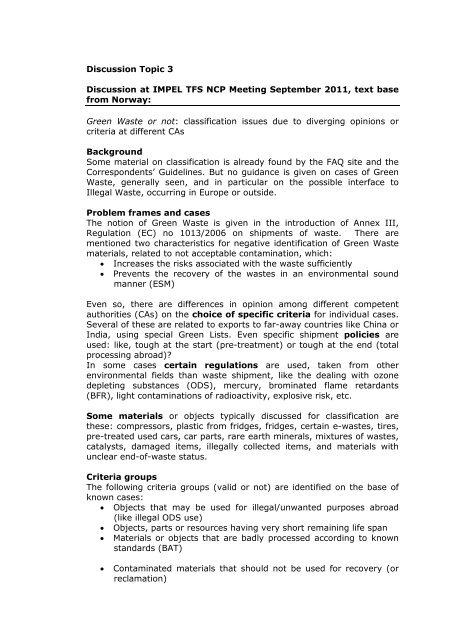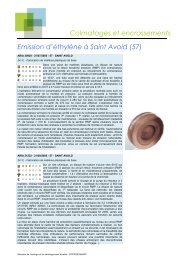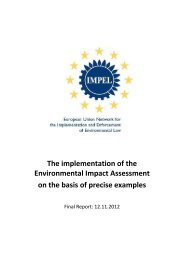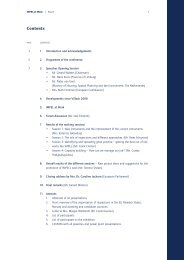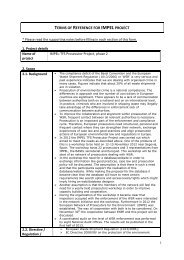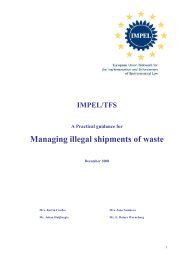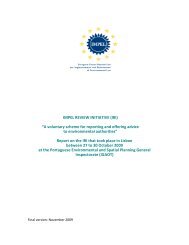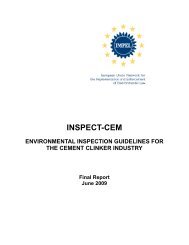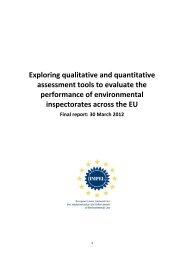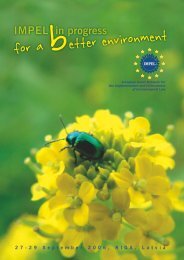Final report - IMPEL-TFS NCP Exchange Days 2011
Final report - IMPEL-TFS NCP Exchange Days 2011
Final report - IMPEL-TFS NCP Exchange Days 2011
Create successful ePaper yourself
Turn your PDF publications into a flip-book with our unique Google optimized e-Paper software.
Discussion Topic 3<br />
Discussion at <strong>IMPEL</strong> <strong>TFS</strong> <strong>NCP</strong> Meeting September <strong>2011</strong>, text base<br />
from Norway:<br />
Green Waste or not: classification issues due to diverging opinions or<br />
criteria at different CAs<br />
Background<br />
Some material on classification is already found by the FAQ site and the<br />
Correspondents’ Guidelines. But no guidance is given on cases of Green<br />
Waste, generally seen, and in particular on the possible interface to<br />
Illegal Waste, occurring in Europe or outside.<br />
Problem frames and cases<br />
The notion of Green Waste is given in the introduction of Annex III,<br />
Regulation (EC) no 1013/2006 on shipments of waste. There are<br />
mentioned two characteristics for negative identification of Green Waste<br />
materials, related to not acceptable contamination, which:<br />
• Increases the risks associated with the waste sufficiently<br />
• Prevents the recovery of the wastes in an environmental sound<br />
manner (ESM)<br />
Even so, there are differences in opinion among different competent<br />
authorities (CAs) on the choice of specific criteria for individual cases.<br />
Several of these are related to exports to far-away countries like China or<br />
India, using special Green Lists. Even specific shipment policies are<br />
used: like, tough at the start (pre-treatment) or tough at the end (total<br />
processing abroad)?<br />
In some cases certain regulations are used, taken from other<br />
environmental fields than waste shipment, like the dealing with ozone<br />
depleting substances (ODS), mercury, brominated flame retardants<br />
(BFR), light contaminations of radioactivity, explosive risk, etc.<br />
Some materials or objects typically discussed for classification are<br />
these: compressors, plastic from fridges, fridges, certain e-wastes, tires,<br />
pre-treated used cars, car parts, rare earth minerals, mixtures of wastes,<br />
catalysts, damaged items, illegally collected items, and materials with<br />
unclear end-of-waste status.<br />
Criteria groups<br />
The following criteria groups (valid or not) are identified on the base of<br />
known cases:<br />
• Objects that may be used for illegal/unwanted purposes abroad<br />
(like illegal ODS use)<br />
• Objects, parts or resources having very short remaining life span<br />
• Materials or objects that are badly processed according to known<br />
standards (BAT)<br />
• Contaminated materials that should not be used for recovery (or<br />
reclamation)


